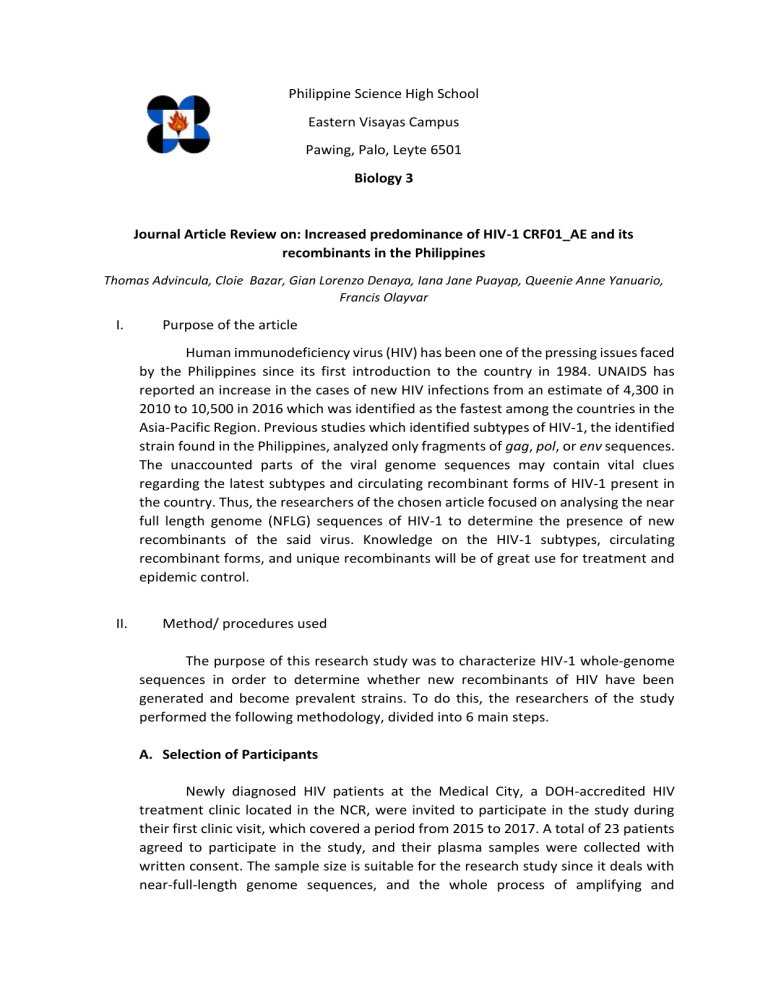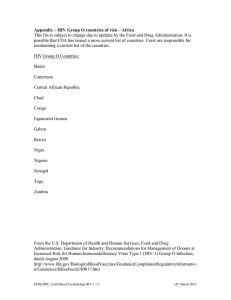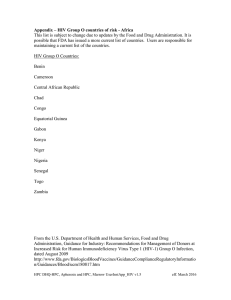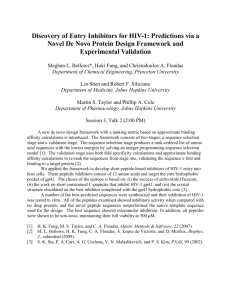
Philippine Science High School Eastern Visayas Campus Pawing, Palo, Leyte 6501 Biology 3 Journal Article Review on: Increased predominance of HIV-1 CRF01_AE and its recombinants in the Philippines Thomas Advincula, Cloie Bazar, Gian Lorenzo Denaya, Iana Jane Puayap, Queenie Anne Yanuario, Francis Olayvar I. Purpose of the article Human immunodeficiency virus (HIV) has been one of the pressing issues faced by the Philippines since its first introduction to the country in 1984. UNAIDS has reported an increase in the cases of new HIV infections from an estimate of 4,300 in 2010 to 10,500 in 2016 which was identified as the fastest among the countries in the Asia-Pacific Region. Previous studies which identified subtypes of HIV-1, the identified strain found in the Philippines, analyzed only fragments of gag, pol, or env sequences. The unaccounted parts of the viral genome sequences may contain vital clues regarding the latest subtypes and circulating recombinant forms of HIV-1 present in the country. Thus, the researchers of the chosen article focused on analysing the near full length genome (NFLG) sequences of HIV-1 to determine the presence of new recombinants of the said virus. Knowledge on the HIV-1 subtypes, circulating recombinant forms, and unique recombinants will be of great use for treatment and epidemic control. II. Method/ procedures used The purpose of this research study was to characterize HIV-1 whole-genome sequences in order to determine whether new recombinants of HIV have been generated and become prevalent strains. To do this, the researchers of the study performed the following methodology, divided into 6 main steps. A. Selection of Participants Newly diagnosed HIV patients at the Medical City, a DOH-accredited HIV treatment clinic located in the NCR, were invited to participate in the study during their first clinic visit, which covered a period from 2015 to 2017. A total of 23 patients agreed to participate in the study, and their plasma samples were collected with written consent. The sample size is suitable for the research study since it deals with near-full-length genome sequences, and the whole process of amplifying and obtaining these sequences will be more tedious should the sample size be of a higher number. The sample size is also similar to the sample size in previous studies. B. Amplification of near full-length HIV-1 genome Viral RNA was obtained from 400 uL of each plasma sample and used for cDNA synthesis with the use of the 3’ and 5’ half genomes obtained through bulk PCR amplification. Near-full-length genome sequences were obtained from a culture supernatant obtained after short-term of plasma samples with peripheral mononuclear blood cells from HIV-1 negative donors. C. Sequence analysis PCR amplicons were quantified using qPCR with KAPA library, barcoded and sequenced thereafter using MiSeq Reagent Nano kit v2 at 300 bp. Average coverage per base was within a 500-8000 range. Final consensus sequence from the library was obtained by assembling raw sequence by using Geneious software or Highperformance Integrated Virtual Environment (HIVE) . Final sequences were then aligned together with HIV-1 subtype references from the Los Alamos HIV Sequence Database using Clustal W. Manual adjustment for optimal alignment was done using SEAVIEW. Subtypes of newly characterized HIV-1 genome were determined through phylogenetic analysis using the neighbor-joining method with Kimura-two model. Reliability of topologies was estimated by bootstrap analysis with 1000 replicates. Recombination patterns were then initially analysed by the jumping profile Hidden Markov Model, then confirmed by Bootscan in Simplot Version. The use of the jumping profile Hidden Markov Model is extremely useful in determining and detecting the extent of recombination that a particular sequence is having. Moreover, the use of Geneious software and HIVE in generating the consensus sequences indicate that the results are accurate and reliable since the aforementioned are US FDA-approved and are regularly used by corporations and government researchers due to the comprehensiveness of the methods employed by these software. D. Molecular evolution clock analysis Divergence times for CRF01_AE subtype was estimates using the Bayesian Markov chain Monte Carlo (MCMC) approach. Relaxed molecular clock were enforced using HKY nucleotide substitution models with a gamma distribution model of amongsite rate heterogeneity. Each MCMC was run for 50 million steps and run for 10000 states. Posterior probabilities were calculated with 10% burn-in and checked for convergence. Maximum clade credibility tree was then generated. The use of 50 million steps for the MCMC approach is indicative that the distribution that was made closely matches the actual desired distribution. E. Genotypic analysis of drug resistance mutations Raw sequence reads generated from MiSeq were uploaded to HyDRA website. HIV drug resistance mutations found in the pol genes (protease, reverse transcriptase, integrase) are reported according to classifications outlined in the Stanford HIV Drug Resistance Database. F. Assigning new nucleotide sequence accession numbers New nucleotide sequence accession numbers were assigned to the newly identified subtypes. The methodology stated above is considered to be the standard procedure for the identification of HIV subtypes, since this methodology is based on the procedure employed by a similar study by Chen et al (2016) on the dissemination of new HIVCRF02/A1 recombinants in Pakistan, but with minor modifications to the current study. III. Outcome/summary of major points covered The results of the study covered the infection stage of the patients, generation of new CRF01_AE recombinants, prevalence of drug-resistant HIV strands, phylogenetic analysis of all sequences, and time of introduction of CRF01_AE in the Philippines. All participanuts were determined to exhibit the late stages of acute HIV. 61% of the participants were identified with the CRF01_AE strain while only 13% inhibited the HIV-B strain. Moreover, 26% of the participants were identified with new recombinants, particularly with CRF01_AE strains. Analysis between the NFLG of the recombinants show only two sites shared between three viruses suggesting a limited distribution in the Philippine population. Drug-resistant mutations were also identified in four patients. Phylogenetic analysis has also shown that all CRF01_AE sequences formed a monophyletic clade suggesting a most recent common ancestor between the sequences. Using the HIV-1 sequence database, the CRF01_AE strains were identified to be the newest subgroup of the CRF01_AE clade which are recent additions to the HIV-1 gene pool in the Philippines with the most recent common ancestor tracing back from 1995. All results suggest that CRF01_AE is the predominant HIV strain in the Philippines contrary to previous studies and has been spread through male to male means. High percentage of recombinants of the virus will ultimately impact genetic variation and imply heavy changed on vaccine development. IV. Journal article’s strengths and weaknesses Due to the fact that the growth rate of new human immunodeficiency virus (HIV) infections in the Philippines was getting faster, the study conducted is relevant as it helped in identifying a different genotype that was recently introduced in the Philippines. The study had a total of twenty-three HIV-1 infected male subjects coming from twelve different cities and provinces, giving the study a diverse group of individuals. The objectives of the study were clearly stated, and were thoroughly answered and discussed at the end of the study. The paper had its own strengths, but it also had its weaknesses. Selection of participants for the study were limited to having one source only which was the Medical City, a Department of Health-accredited HIV treatment clinic, however the participants came from different cities and provinces in the country. The table of data of HIV-1 infected individuals in the Philippines that was presented lack some information like in the transmission route, two subjects had N/A meaning the data wasn’t available. Although the study had good and proper citations in the paper, some resources that were cited beyond 2009 shouldn’t have been included since the paper was published in 2019. V. Application of article to related studies and reaction Researchers can conduct expanded phylogenetic studies of recently transmitted HIV from individuals with characterized demographic and risk factor information conducted to determine what caused a dramatic shift in viral HIV-1 genotype in the Philippines. The genetic variation complexity through extensive recombination and marked increase of recombinant in a population may have major suggestions in vaccine development and patient treatment. The significant difference of the results of this study and a previous study suggests that HIV-1 genotypes distribution can significantly be underestimated using only partial genome sequences. Moreover, researchers used next-generation sequencing in this study for detection of drug-resistant mutations. The high frequency in the treatment-naïve population of the Philippines that showed in the results of this study confirmed the monitoring drug-resistant mutation importance using more sensitive methods. This indicates that it is better to use near-full-length genome sequences and more sensitive methods in monitoring drug-resistant mutation for future studies in this field to have more accurate results. Analyzing dramatic shifts among HIV-1 subtypes, circulating recombinant forms, unique recombinant, and frequency of drug-resistant viruses in a population are important and necessary to develop better epidemic control, effective vaccines and treatment of HIV-1-infected individuals. The research has found this journal article to be very informative. Not only does the article give the research more background and information regarding HIV and phylogenetics, it demonstrates how it can be applied into practical situations. It is interesting to know that this is how phylogenetic trees are being used in the field of research. How the analysis helped in tracing the possibly origins of the different recombinants has shed new light regarding practical use of phylogeny.



